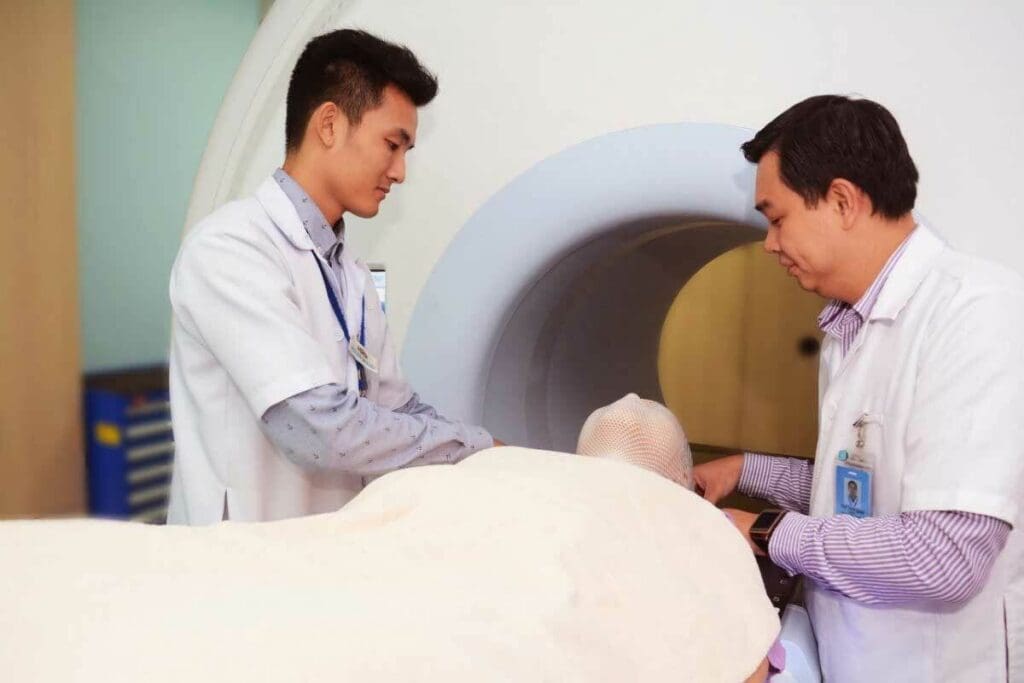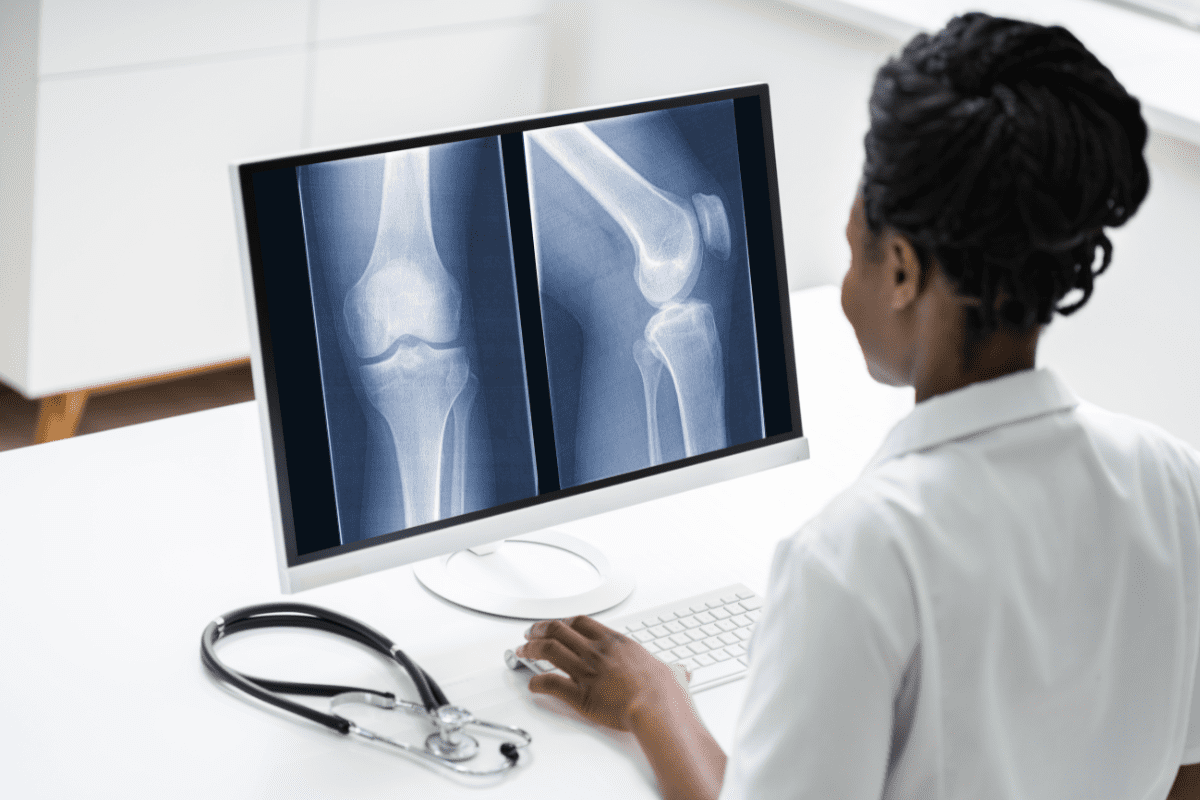Last Updated on November 27, 2025 by Bilal Hasdemir

Radiation or chemo: 7 key differences between radiation and chemotherapy explained.
Cancer treatment has evolved, giving patients many options. Two main treatments are chemotherapy and radiation therapy. They fight cancer in different ways.
Chemotherapy uses special drugs to kill cancer cells. On the other hand, radiation therapy uses high-energy beams to target cancer cells. Knowing how these treatments differ is key for patients to choose wisely.
At Liv Hospital, we blend advanced knowledge with a focus on the patient. This helps patients understand their treatment options better.
Key Takeaways
- Chemotherapy and radiation therapy are two different cancer treatments.
- Chemotherapy uses special drugs to kill cancer cells.
- Radiation therapy uses high-energy beams to target cancer cells.
- Understanding the differences between treatments is key for making informed choices.
- Liv Hospital offers a patient-centered approach to cancer treatment.
Understanding Cancer Treatments: An Overview

Cancer treatment has many options, with chemotherapy and radiation therapy being key. These treatments have changed a lot, giving hope to people all over the world. The choice between them depends on the cancer type and stage.
The Role of Cancer Treatments in Modern Medicine
Chemotherapy and radiation therapy are vital in cancer treatment today. Chemotherapy uses drugs to kill cancer cells. Radiation therapy uses high-energy rays to destroy cancer cells. Both have gotten better over time, making them more effective and less harsh.
These treatments do more than just fight cancer. They also help ease symptoms and make life better for patients.
Why Treatment Selection Matters
Choosing the right treatment is key to managing cancer well. The choice between chemotherapy and radiation therapy depends on many things. These include the cancer type, its stage, and the patient’s health.
| Factor | Chemotherapy | Radiation Therapy |
|---|---|---|
| Cancer Type | Effective for systemic cancers (e.g., leukemia) | Effective for localized tumors |
| Treatment Goal | Kill cancer cells throughout the body | Target and destroy cancer cells in a specific area |
| Side Effects | Can cause systemic side effects (e.g., hair loss, nausea) | Can cause localized side effects (e.g., skin irritation, fatigue) |
Knowing these details helps doctors and patients choose the best treatment plan.
What is Chemotherapy?

Chemotherapy is a way to treat cancer by targeting cells that grow fast all over the body. It’s a key part of cancer treatment, often used with surgery and radiation therapy too.
Definition and Basic Principles
Chemotherapy uses drugs to kill or slow down cancer cells. These drugs target cells that grow quickly, like most cancer cells. Chemotherapy can be given in different ways, like taking pills, getting shots, or other methods.
The right chemotherapy drugs depend on the cancer type, its stage, and the patient’s health. Chemotherapy drugs fall into groups like alkylating agents, antimetabolites, anthracyclines, and plant alkaloids.
How Chemotherapy Works Against Cancer Cells
Chemotherapy stops cancer cells from growing by messing with their cell division. Different types of chemotherapy drugs work in different ways. Some damage DNA, while others mess with microtubules needed for cell division.
Types of Chemotherapy Drugs
There are many types of chemotherapy drugs, each with its own way of working and side effects. Some common ones include:
- Alkylating agents, which damage DNA to stop cancer cells from copying.
- Antimetabolites, which block DNA and RNA production to stop cancer cell growth.
- Anthracyclines, which get in between DNA strands to stop DNA and RNA making.
- Plant alkaloids, which mess with microtubules needed for cell division.
The way chemotherapy is given can affect how well it works and its side effects. Knowing about the different types and how they’re given helps patients make better choices about their treatment.
What is Radiation Therapy?
Radiation therapy is a big step in fighting cancer. It uses high-energy radiation to kill cancer cells. This treatment is also known as radiotherapy. It aims to destroy or damage cancer cells so they can’t grow and divide.
There are two ways to give radiation therapy. You can get it from outside the body or from inside, near the tumor. The choice depends on the cancer type, where it is, and how far it has spread.
Basic Principles and Definition
Radiation therapy works by harming the DNA of cancer cells. This stops them from making copies and leads to their death. It can be used alone or with other treatments like surgery or chemotherapy to work better.
This treatment is focused on cancer cells in a specific area. It tries to avoid harming healthy tissues nearby. New technology has made radiation therapy more precise. This means it can give more radiation to the tumor while protecting healthy cells.
How Radiation Therapy Targets Cancer Cells
Radiation therapy uses ionizing radiation to damage cancer cells’ DNA. This stops them from growing and dividing, causing them to die. The goal is to kill cancer cells without harming healthy tissues too much.
How well radiation therapy works depends on several things. These include the cancer type and stage, and the patient’s health. Radiation oncologists plan and deliver the treatment carefully. This helps get the best results with fewer side effects.
Types of Radiation Therapy
There are different types of radiation therapy, each with its own use. The main types are:
- External Beam Radiation Therapy (EBRT): This is the most common type. It uses radiation from a machine outside the body.
- Brachytherapy: This involves placing a radioactive source inside or near the tumor. It delivers a high dose of radiation directly to the cancer cells.
- Stereotactic Body Radiation Therapy (SBRT): This delivers precise, high doses of radiation to tumors in a few fractions. It’s often used for hard-to-reach tumors.
| Type of Radiation Therapy | Description | Common Applications |
|---|---|---|
| External Beam Radiation Therapy (EBRT) | Radiation delivered from outside the body | Various cancers, including breast, prostate, and lung cancer |
| Brachytherapy | Radioactive source placed inside or near the tumor | Prostate, cervical, and breast cancers |
| Stereotactic Body Radiation Therapy (SBRT) | High doses of radiation delivered precisely to tumors | Tumors that are difficult to target, such as those in the lung or liver |
Difference #1: Treatment Approach and Mechanism
Chemotherapy and radiation therapy differ in how they treat cancer. Knowing these differences helps patients choose the best treatment for them.
Chemotherapy’s Systemic Approach
Chemotherapy uses drugs to fight cancer cells all over the body. It’s great for cancers that have spread or might spread. The National Center for Biotechnology Information says it stops cancer cells from growing and dividing.
Radiation’s Localized Targeting
Radiation therapy focuses on specific areas with cancer. It uses energy to kill cancer cells, keeping healthy tissues safe. It’s used for cancers in one area, like some breast, prostate, or lung cancers.
Cellular Impact Differences
Chemotherapy and radiation therapy affect cells differently. Chemotherapy harms cells that grow fast, causing side effects like hair loss and nausea. Radiation therapy targets specific areas, causing side effects based on where it’s used.
In short, chemotherapy treats the whole body, while radiation therapy targets specific areas. Knowing this helps patients and doctors choose the right treatment.
Difference #2: Method of Delivery
It’s key to know how chemotherapy and radiation therapy are given. This affects how well they work and the patient’s life during treatment.
How Chemotherapy is Administered
Chemotherapy can be given in different ways. This depends on the cancer type, its stage, and the patient’s health. Here are the main methods:
- Oral administration: Chemotherapy drugs are given in pill or liquid form.
- Intravenous (IV) administration: Chemotherapy drugs are delivered directly into a vein.
Intravenous administration is the most common. It allows for higher doses and direct delivery to cancer cells. Oral chemotherapy is taken at home but needs strict following of the regimen.
How Radiation Therapy is Delivered
Radiation therapy comes in two main types: external and internal. External beam radiation therapy (EBRT) uses a machine outside the body to send beams to the cancer. Internal radiation therapy, or brachytherapy, places radioactive material inside or near the tumor.
The choice between external and internal radiation depends on the cancer type, stage, and patient’s health. External beam radiation therapy is used for widespread or hard-to-reach tumors. Brachytherapy is for tumors that are closer to the surface.
In summary, chemotherapy and radiation therapy have different delivery methods. This affects how patients experience these treatments. Knowing these differences is important for making informed cancer treatment choices.
Difference #3: Side Effects and Management
Chemotherapy and radiation therapy have different side effects. It’s important for patients to know about these to prepare and cope better.
Common Side Effects of Chemotherapy
Chemotherapy can cause many side effects because it affects the whole body. Some common ones are:
- Nausea and Vomiting: Often managed with antiemetic medications.
- Hair Loss: Can be emotionally challenging for patients.
- Fatigue: Persistent tiredness that may last throughout the treatment.
- Increased Risk of Infection: Due to the suppression of the immune system.
Common Side Effects of Radiation Therapy
Radiation therapy also has its side effects. Some common ones are:
- Skin Reactions: Ranging from redness to blistering, similar to sunburn.
- Fatigue: Similar to chemotherapy, fatigue is a common complaint.
- Hair Loss: But limited to the area being treated.
- Localized Pain or Discomfort: Depending on the area being irradiated.
Managing Side Effects of Both Treatments
Managing side effects from both treatments requires a few steps. This includes:
- Medication: To alleviate symptoms such as nausea, pain, and to prevent infections.
- Lifestyle Adjustments: Such as dietary changes, rest, and exercise tailored to the patient’s condition.
- Supportive Care: Including counseling and support groups to address emotional and psychological impacts.
By understanding and managing these side effects, patients can improve their quality of life during and after treatment.
Difference #4: Treatment Duration and Frequency
Chemotherapy and radiation therapy have different schedules. It’s key for patients to grasp these differences to manage their treatment well.
Typical Chemotherapy Schedules
Chemotherapy is given in cycles, with breaks in between. The length and how often it’s given vary based on the cancer type, its stage, and the patient’s health.
- Cycle Length: Usually 2 to 4 weeks.
- Treatment Duration: Can be a few months to over a year.
- Frequency: May be weekly, every two weeks, or every three weeks.
Typical Radiation Therapy Schedules
Radiation therapy is given daily, from Monday to Friday, for a set number of weeks. It’s split into smaller doses to reduce side effects.
- Treatment Duration: Usually 3 to 9 weeks.
- Frequency: Given once a day, five days a week.
- Session Length: Sessions are short, lasting 10 to 30 minutes.
Recovery Timeframes for Each Treatment
Recovery times differ a lot between chemotherapy and radiation therapy. Some patients recover fast, while others take longer.
- Chemotherapy Recovery: Can take months to a year or more after treatment ends.
- Radiation Therapy Recovery: Starts during treatment and goes on for weeks to months after it ends.
Knowing the treatment duration and frequency is vital. It helps patients prepare physically and emotionally. By understanding what’s ahead, they can better handle their treatment and its side effects.
Radiation or Chemo: Which is More Effective for Different Cancer Types
Cancer treatments work differently for each type and stage. Both chemotherapy and radiation therapy are key in fighting cancer. But, their success depends on the cancer type.
Cancer Types Best Treated with Chemotherapy
Chemotherapy is often chosen for cancers that spread or might spread. It works well for:
- Leukemia: Chemotherapy targets cancerous white blood cells.
- Lymphoma: Both Hodgkin and non-Hodgkin lymphoma respond well to chemotherapy.
- Testicular Cancer: Chemotherapy is very effective, even when it has spread.
Cancer Types Best Treated with Radiation
Radiation therapy is best for cancers that haven’t spread much. It’s effective for:
- Early-stage Breast Cancer: Radiation follows lumpectomy to kill remaining cancer cells.
- Prostate Cancer: Radiation treats prostate cancer, mainly in early stages.
- Head and Neck Cancers: Radiation therapy works well for these cancers.
Effectiveness Metrics and Success Rates
Success in chemotherapy and radiation is measured in several ways:
- Survival Rates: The percentage of patients surviving after treatment.
- Tumor Response: How much the tumor shrinks or disappears.
- Recurrence Rates: The chance of cancer coming back after treatment.
Research shows that chemotherapy and radiation work differently for each cancer. For example, chemotherapy is very effective for testicular cancer. Radiation is best for early-stage breast cancer.
Knowing these differences helps in choosing the right treatment. Healthcare providers consider the cancer type, stage, and patient’s health. This way, they can suggest the best treatment plan.
Difference #6: Combined Therapy Approaches
Using both chemotherapy and radiation is key in fighting cancer. This method combines the best of both worlds. It aims to improve treatment results and help patients more.
When Both Treatments Are Used Together
Chemotherapy and radiation therapy are often used together. Chemotherapy attacks cancer cells all over the body. Radiation therapy targets specific areas with cancer.
This combo offers a strong attack on cancer cells. It helps control tumors and reduces the chance of cancer coming back.
Sequential vs. Concurrent Treatment
There are two ways to use these therapies together. Sequential treatment means one therapy comes after the other. Concurrent treatment means both are used at the same time.
Choosing between these depends on the cancer type, the patient’s health, and treatment goals. Studies show concurrent treatment works well for some cancers, like head and neck cancers.
| Treatment Approach | Description | Benefits |
|---|---|---|
| Sequential Treatment | Administering one therapy after the other | Allows for recovery time between treatments |
| Concurrent Treatment | Administering both therapies simultaneously or in close proximity | Can enhance local control and reduce recurrence risk |
Enhanced Efficacy and Challenges
Combined therapy is more effective but comes with challenges. Patients might face more side effects. It’s important to manage these to keep the patient’s quality of life good.
Despite the challenges, the benefits of combined therapy are often worth it. With careful planning, doctors can make both treatments work better together.
Difference #7: Decision Factors for Breast Cancer Treatment
Choosing between radiation therapy and chemotherapy for breast cancer depends on several things. These include the tumor’s stage and type, and the patient’s health and wishes.
Radiation vs. Chemo for Breast Cancer
Radiation therapy and chemotherapy are both effective against breast cancer. But they work in different ways. Radiation therapy uses high-energy rays to kill cancer cells in the tumor area. On the other hand, chemotherapy uses drugs to kill cancer cells all over the body.
The choice between these treatments depends on the breast cancer’s specifics. For example, early-stage cancer might get radiation after surgery. But more advanced cancers might need chemotherapy.
Factors That Influence Treatment Selection
Many factors affect the choice of treatment for breast cancer. These include:
- The cancer’s stage and grade
- The presence of specific biomarkers, like hormone receptors or HER2
- The patient’s overall health and medical history
- Patient preferences and values
It’s important to understand these factors to make an informed decision about treatment.
Latest Advances in Breast Cancer Treatment
Recent breakthroughs in breast cancer treatment have greatly improved outcomes. These include:
- Targeted therapies that attack cancer cells while sparing normal cells
- Immunotherapies that use the immune system to fight cancer
- Advances in radiation therapy techniques, like intensity-modulated radiation therapy (IMRT)
These advancements have made treatments more effective and reduced side effects for many patients.
Conclusion: Making Informed Decisions About Cancer Treatment
It’s key for patients to know the difference between chemotherapy and radiation therapy. This knowledge helps them make smart choices about their cancer treatment. We’ve looked at how these treatments work and their effects.
Chemotherapy and radiation therapy are both good ways to fight cancer. But they attack cancer in different ways. Chemotherapy uses drugs to target cancer cells all over the body. Radiation therapy uses high-energy rays to target cancer cells in one area.
Choosing between these treatments depends on many things. This includes the type and stage of cancer, and the patient’s situation. When thinking about cancer treatment options, it’s important to look at the good and bad sides of each. Patients should talk to their doctor to find the best treatment for them.
Understanding your treatment options is important. Knowing if is radiation and chemo the same or different helps patients make better choices. This knowledge helps them find the best way to fight their cancer.
FAQ
Are chemo and radiation the same?
No, chemotherapy and radiation therapy are not the same. Chemotherapy uses drugs to kill cancer cells. Radiation therapy uses high-energy rays to target and destroy cancer cells.
What is the difference between chemotherapy and radiation therapy?
Chemotherapy targets cancer cells throughout the body. Radiation therapy targets specific areas where cancer cells are present. This is the main difference between them.
Is radiotherapy the same as chemotherapy?
No, radiotherapy (radiation therapy) and chemotherapy are not the same. They are both used to treat cancer but work differently and have different uses.
What are the common side effects of chemotherapy and radiation therapy?
Chemotherapy can cause hair loss, nausea, and fatigue. Radiation therapy can cause skin irritation, fatigue, and hair loss in the treated area. Managing these side effects is key to a good treatment outcome.
How are chemotherapy and radiation therapy administered?
Chemotherapy is given through intravenous infusion or oral medication. Radiation therapy is delivered by a machine targeting the specific area of the body with cancer cells.
Can chemotherapy and radiation therapy be used together?
Yes, both treatments can be used together. This can be done in a combined therapy approach, depending on the cancer type and stage, and individual patient factors.
What are the latest advances in breast cancer treatment?
Advances in breast cancer treatment include targeted therapies, immunotherapies, and precise radiation techniques. These have improved outcomes and reduced side effects for many patients.
How do I decide between radiation therapy and chemotherapy for breast cancer?
The choice between radiation therapy and chemotherapy depends on several factors. These include the cancer stage and type, and individual patient characteristics. It’s important to consult with a healthcare professional to decide the best treatment.
What is the difference between external beam radiation and brachytherapy?
External beam radiation therapy delivers radiation from outside the body. Brachytherapy places a radioactive source directly inside or near the tumor. Both are used to treat cancer but have different uses and advantages.
How long does chemotherapy and radiation therapy treatment typically last?
Treatment duration varies based on cancer type and stage, and individual factors. Treatment can last from a few weeks to several months or even years.
What are the effectiveness metrics and success rates for chemotherapy and radiation therapy?
Effectiveness metrics and success rates vary by cancer type and stage. Healthcare professionals use metrics like overall survival rates and disease-free survival rates to evaluate treatment success
Reference
- National Cancer Institute. (2023). Chemotherapy and You: Support for People With Cancer. https://www.cancer.gov/about-cancer/treatment/types/chemotherapy






